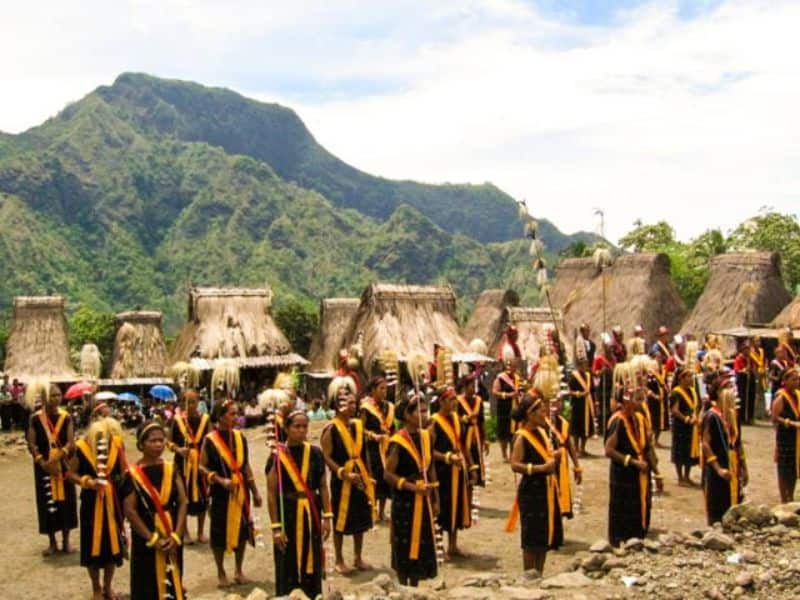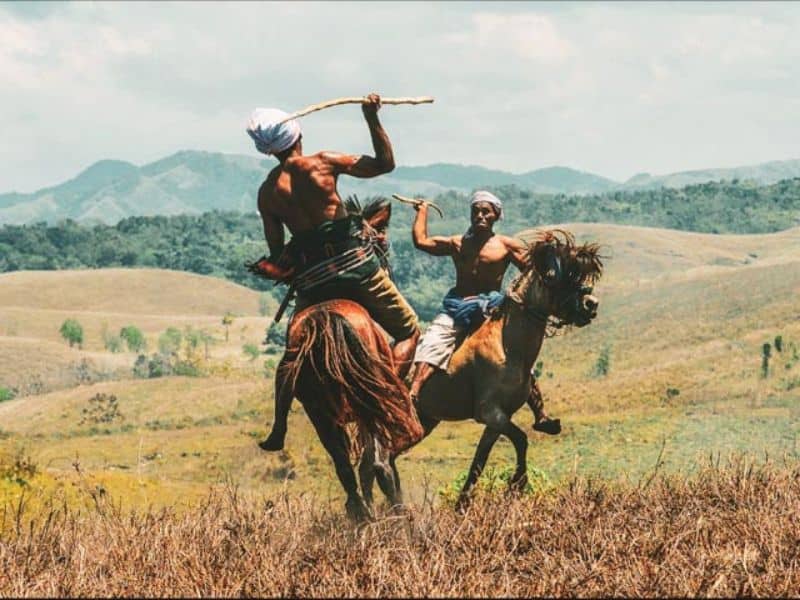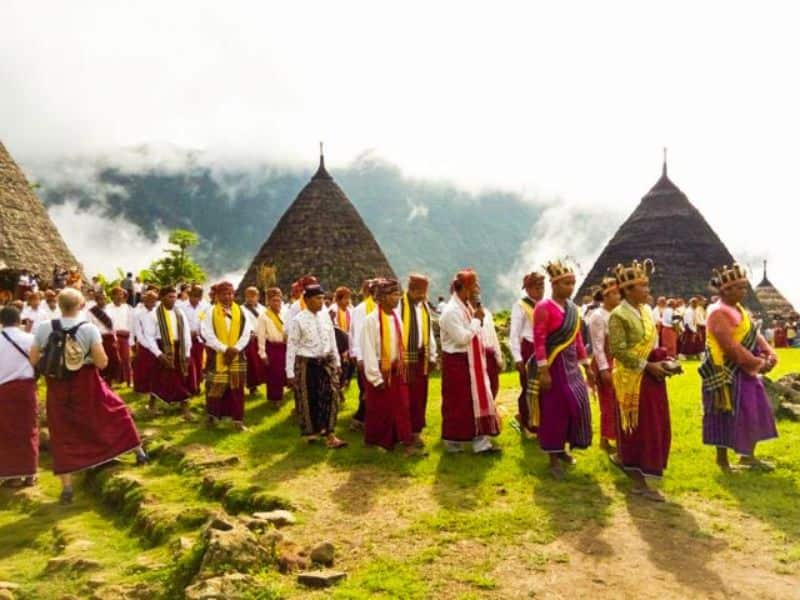NTT's traditional ceremonial traditions are still very well preserved today, see some of the traditional rituals below!
East Nusa Tenggara is a province that is famous for its natural beauty, especially the beauty of the sea which borders the Flores Sea in the North and the Indian Ocean in the South.
This province, which consists of beautiful islands, has a strong cultural presence, one of which is the NTT traditional ceremony tradition. Various tribes, such as Sumba, Flores, Alor, and Timor, carry out traditional NTT ceremonies.
NTT traditional ceremonies have various regional specific purposes and meanings. For example, the traditional Pasola ceremony of the Sumbanese people is a war ceremony, aimed at asking for protection and wealth.
The following are several NTT traditional ceremony traditions that are still carried out today.
NTT Traditional Ceremonial Traditions
1. Reba Traditional Ceremony
The Reba tradition is a traditional ceremony of the largest Ngada community in East Nusa Tenggara. This event is celebrated by all levels of society and has deep value.

Reba is an annual event aimed at commemorating the traditional new year, expressing gratitude for the gift of the land, honoring ancestors, and celebrating unity in traditional houses and tribes.
NTT's traditional ceremonial traditions have extraordinary moral, social and cultural meaning. This event instills the virtues of unity, peace and mutual cooperation. Apart from that, the Reba ceremony strengthens ties of brotherhood and fosters a sense of solidarity.
2. Elkoil Oot Ceremony
Travela, the Elkoil Oot Ceremony is a traditional NTT ceremony to conjure rain. This ceremony is carried out when there is a drought in the area.
A traditional elder leads the Elkoil Oot ceremony which includes prayers and rituals. One of the most important ceremonies is ringing the Elkoil, an heirloom gong that cannot be traded or rung carelessly.
This hereditary gong is thought to have the ability to summon rain. Therefore, the people of NTT believe that sounding the heritage gong will bring rain and end drought.
Also read later:
- Hidden Gem NTT Tourism 8 Destinations You Must Visit
- Typical Culinary of NTT
- 8 Most Interesting Unique Facts about Kelimutu Lake to Know!
3. Pasola Rite
In western Sumba, residents celebrate the rice planting season through a traditional ceremony known as Pasola. This NTT traditional ceremony is a ritual to honor Marapu, ask for forgiveness, wealth and abundant harvests.

At the Pasola event, two groups of youth from different tribes or villages ride horses and throw wooden javelins at each other. Javelin is made from Banyan tree wood which is sharpened and sharpened.
The Pasola ritual usually lasts for several days and culminates in a Sumbanese arts and cultural performance. The Pasola Ceremony is one of the most famous attractions in East Nusa Tenggara.
4. Zairo Ceremony
Travela, Zairo is a traditional NTT ceremony carried out by the people of West Sumba. This ceremony is intended to apologize to the Goddess of Rice who is considered the protector of rice plants.
Apart from that, this event is an effort to encourage the safety and welfare of the community. The Zairo ceremony is carried out when rice plants experience crop failure which is thought to have been triggered by a lightning strike.
The people of West Sumba believe that the soul or spirit of rice that has been scorched by lightning will wander endlessly. Therefore, the Zairo ceremony is carried out to revive the soul or spirit of rice.
Zairo ceremonies are usually held in traditional houses, in gardens or in areas where harvest failure occurs. Zairo celebrations usually involve the entire family and community members.
In this NTT traditional ceremony, people will pray and make offerings to the Goddess of Rice. Offerings usually consist of sacrificial animals such as chickens or pigs, as well as food and drink.
5. Penti Ceremony
Travela, the Penti Ceremony is a traditional ceremony carried out by the Manggarai Community of East Nusa Tenggara to express gratitude for the abundant harvest.
This traditional party is celebrated every year in July, August, September, or before December. The Manggarai people believe that these months determine the success of the harvest in the following year.
During this event, Penti offered sacrificial animals, including a male pig and a rooster. The male pig symbolizes strength and persistence in caring for the garden, while the rooster symbolizes time and nature.
The Penti Ceremony is one of the important traditional NTT ceremonial traditions of the Manggarai Community, which is a form of appreciation for God, Ancestors, the Environment and fellow humans.
6. Lepa Bura Custom
The Lepa Bura Ritual is a traditional ceremony carried out by the Lamaholot Community of East Nusa Tenggara to welcome newly harvested rice. Initially the Lepa Bura ceremony was carried out by the Lamaholot community who adhered to traditional beliefs.
This ceremony asks for safety and prosperity from Lera Wulan Tana Ekan, Lord of Heaven and Earth. Following the establishment of Catholicism in East Nusa Tenggara, the Lepa Bura ceremony underwent changes to honor Jesus Christ.
The Lepa Bura ceremony is often held for several days. On the first day, the community will gather at the village head's house to worship and make offerings to God, as well as abstain and fast from fresh garden produce.
On the second day, people will dance and sing traditional music. On the third day, the community will share their harvest with the entire community.
7. Se'i, Typical Rote Smoked Meat
The ancestors of the NTT people used smoking to maintain the quality of their beef. This technique produces results in the form of a typical NTT food, namely Se'i.
Se'i is a smoked meat product typical of one of the districts in NTT, Rote Ndao District. Se'i comes from the Rote regional language which means beef cut into small pieces lengthwise and smoked over hot coals until cooked.
Se'i beef products have a distinctive aroma, red color, smooth texture and delicious taste.
8. Bijalungu Hiu Paana Ceremony
Travela, Bijalungu Hiu Paana is a traditional NTT ceremony celebrated by the people of Wanokaka, West Sumba Regency, at the end of February. This ceremony celebrates the new season and prays for a bountiful harvest.
This celebration includes various ceremonies, including chicken slaughtering by Rato Marapu, the leader of the Marapu ceremony, as well as the Kabaena Kebo (buffalo throwing) and Teung (buffalo cutting) ceremonies.
The Wanokaka people highly value their cultural heritage, including the Bijalungu Hiu Paana ceremony. This ceremony reflects the beliefs, customs and values of the local community.
9. Lota script
Apart from its typical food, NTT has an original script known as the Lota script. So, the Lota script is widely used by the Ende tribe who are Muslim.
According to the official website of the Bali Cultural Values Preservation Center, Directorate General of Culture of the Republic of Indonesia, the Lota script first appeared in Ende around the 16th century, during the reign of King of Goa XIV, I Mangngarangi Daeng Manrabia or known as Sultan Alaudin (1593-1639).
The Lota script is a direct descendant of the Bugis script. However, there are eight Lota Ende characters that do not appear in the Bugis script, Bha, Dha, Fa, Gha, Mba, Nda, Ngga, and Rha. However, the Lota Ende script does not have the six Bugis characters: Ca, Ngka, Mpa, Nra, Nyca, and Nya.
Read other interesting information:
- 9 Most Popular Traditional Ceremonies in Indonesia
- Balinese Traditional Ceremonies That You Shouldn't Miss When In Bali
10. Bonet Dance
Travela, Bonet Dance is a dance that is always present in the traditional and cultural activities of the Dawan tribe in NTT.
This dance is almost always present in traditional activities and events of the Dawan community, such as birth ceremonies, weddings, deaths, house building ceremonies, rain greetings, and so on.
The word bonet comes from several Dawan language words, including Na Bonet which means "to surround, enclose, surround or encircle". This corresponds to a circular dancing formation.
The Bonet dance is distinguished by its circular formation and use of poetry or rhymes which reflect the richness of the Dawan tribe's oral literature. This NTT traditional ceremony tradition is very interesting, you know!
These ceremonies reflect the beliefs, traditions and values of the NTT people. Each ceremony not only reflects beliefs and traditions, but deep values that contribute to the identity of the NTT people.
So that's information about NTT traditional ceremony traditions, I hope it's useful, friends, Travela!



